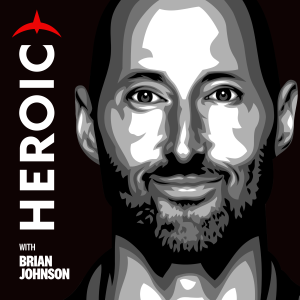
You Are Heroic with Brian Johnson
Health & Fitness:Alternative Health

In our last couple +1s, we talked about a key (arguably the #1 key) predictor of our long-term health/morbidity: our visceral fat.
We also discussed the Optimized WHtR (Waist-to-Height Ratio!) that gives us some insight on how we’re doing with that facet of our lives. (+1 +1 +1 for the
There are, of course, a number of things we can do to Optimize our WHtR.
Eat + Move + Sleep Fundies for the win!
But…
The #1 thing?
Nutrition.
At the end of the day, if we want to get our weight Optimized, we need to get our nutrition Optimized. (And, that requires us to get our metabolism/insulin Optimized.)
For the record: I’m agnostic as to whether you should go vegan or paleo or keto or carnivore or whatever strikes your fancy.
I am, however, very (!) committed to a) encouraging you to GO ALL IN on whatever path you choose while b) remaining open to experimenting as new data comes in while c) making sure whatever path you choose includes limiting/eliminating sugar and flour and ultra-processed foods while d) reminding you that the more weight you need to lose, the MORE committed you’ll need to be, the more important the margins will be, and the brighter your lines will need to be.
But that’s not quite the point of Today’s +1.
Today I want to talk about the fact that exercise, as awesome as it is, is PRIMARILY a WELL-BEING tool *not* a WEIGHT-LOSS tool.
We talk about this in our Notes on Jeff Volek and Stephen Phinney’s book The Art and Science of Low Carbohydrate Living.
It’s one of their “Ten Clinical Pearls.”
They tell us: “Exercise is a wellness tool. It is not a weight loss tool.”
They also tell us: “Exercise done by heavy people causes a lot of collateral damage. Think ankles, knees, hips, and low backs. So here’s a radical idea… let heavy people try carbohydrate restriction first, lose some weight (which most do without resorting to exercise), and then let them decide when to become more active once they are empowered, energized, and lighter of foot. Making heavy people exercise is punitive. Enabling heavy people to lose weight and then become more fit is smart.”
So…
Exercise is unquestionably awesome for our overall well-being. It’s like that little bit of Ritalin and Prozac a la John Ratey’s Spark. And, as Sonja Lyubomirsky tells us in The How of Happiness, it’s been shown to be as effective as Zoloft in reducing depression.
But, again, remember: Exercise is NOT primarily a weight-loss tool. It’s a wellness tool.
I often think of this when I’m out on the trail and see significantly overweight people training super hard. It makes a LOT more sense to slow down and get your weight down THEN train.
To put it in perspective, I used to carry something heavy for the first and last 5 minutes up to the start of the trail—either a 50-pound sand bag or a bucket filled with 50 pounds of gravel-rocks. (That’s like me!)
People often looked at me and asked, “What are you carrying?!” Then we’d have a sweet, Love 2.0 moment as we chat about Spartan Races, etc.
But...
No one ever pauses to think about the fact that running with 15 to 25 to 50+ extra pounds is AT LEAST as weird as me carrying a 50-pound bag of sand or a 50-pound bucket of rocks!
So...
If you’re carrying extra weight, consider putting ALL your energy into dropping it THEN hitting your higher-impact aerobic training. (Note: Carry on with the lower-impact MAF aerobic goodness and resistance training during the transition!)
One more time…
Let’s remember: “Exercise is a wellness tool. It is not a weight loss tool.”
More Episodes
012345678910111213141516171819
Create your
podcast in
minutes
- Full-featured podcast site
- Unlimited storage and bandwidth
- Comprehensive podcast stats
- Distribute to Apple Podcasts, Spotify, and more
- Make money with your podcast
It is Free
- Privacy Policy
- Cookie Policy
- Terms of Use
- Consent Preferences
- Copyright © 2015-2024 Podbean.com




